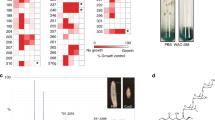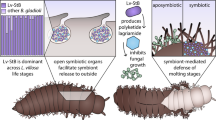Abstract
THE extracellular bacterium Pseudomonas savastanoi (Smith) Stevens has been suspected as a mutualist of Dacus oleae Gmelin for more than fifty years. Petri1 described in detail how the bacterium was preserved through the pupal and adult stages in an oesophageal diverticulum in the head of the olive fly, and also discovered how the bacteria were transmitted from generation to generation. During oviposition the egg is smeared with the bacteria which are housed in invaginations near the distal end of the ovipositor. The bacteria enter the egg through the micropyle and ultimately become established in caeca arising from the anterior end of the larval mid gut. The functions of this symbiote, however, were not determined.
This is a preview of subscription content, access via your institution
Access options
Subscribe to this journal
Receive 51 print issues and online access
$199.00 per year
only $3.90 per issue
Buy this article
- Purchase on Springer Link
- Instant access to full article PDF
Prices may be subject to local taxes which are calculated during checkout
Similar content being viewed by others
References
Petri, L., Zentr. Bakt. Parasitenk. Infekt., II, 26, 357 (1910).
Stammer, H. J., Morphol. Okol. Tiere, 15, 481 (1929).
Hellmuth, H. Z., Morphol. Okol. Tiere, 44, 438 (1956).
Hagen, K. S., Santas, L., and Tsecouras, A., in Radiation and Radio-Isotopes Applied to Insects of Agricultural Importance, 333 (I.A.E.A., Vienna, 1963).
Narasaki, T., and Katakura, K., Tech. Bull. Kagawa Agr. Coll., 6, 194 (1954).
Goldberg, L., and DeMeillon, B., Biochem. J., 43, 379 (1948). Sedee, P. D. J. W., Acta Physiol. Parmacol. Neerl., 3, 262 (1954). House, H. L., Can. J. Zool., 32, 331 (1954). McGinnis, A. J., Newburgh, R. W., and Cheldelin, V. H., J. Nutrition, 58, 309 (1956). Hodgson, E., Cheldelin, V. H., and Newburgh, R. W., Canad. J. Zool., 34, 527 (1956). Friend, W. G., Backs, R. H., and Cass, L. M., Canad. J. Zool., 35, 535 (1957). Singh, K. R. P., and Brown, A. W. A., J. Insect Physiol., 1, 199 (1957). Chang, J. T., and Wang, M. Y., Nature, 181, 566 (1958). Cheldelin, V. H., and Newburgh, R. W., Ann. N. Y. Acad. Sci., 77, 373 (1959). Gingrich, R. E., Ann. Entomol. Soc. Amer., 57, 351 (1964).
Author information
Authors and Affiliations
Rights and permissions
About this article
Cite this article
HAGEN, K. Dependence of the Olive Fly, Dacus oleae, Larvae on Symbiosis with Pseudomonas savastanoi for the Utilization of Olive. Nature 209, 423–424 (1966). https://doi.org/10.1038/209423a0
Issue Date:
DOI: https://doi.org/10.1038/209423a0
This article is cited by
-
Variations in the Bacterial Communities in Anastrepha obliqua (Diptera: Tephritidae) According to the Insect Life Stage and Host Plant
Current Microbiology (2020)
-
Assessment of the Bacteria community structure across life stages of the Chinese Citrus Fly, Bactrocera minax (Diptera: Tephritidae)
BMC Microbiology (2019)
-
Horizontal transfer and finalization of a reliable detection method for the olive fruit fly endosymbiont, Candidatus Erwinia dacicola
BMC Biotechnology (2019)
-
Assessing the effects of gut bacteria manipulation on the development of the oriental fruit fly, Bactrocera dorsalis (Diptera; Tephritidae)
Symbiosis (2018)
-
Transcriptomic responses of the olive fruit fly Bactrocera oleae and its symbiont Candidatus Erwinia dacicola to olive feeding
Scientific Reports (2017)
Comments
By submitting a comment you agree to abide by our Terms and Community Guidelines. If you find something abusive or that does not comply with our terms or guidelines please flag it as inappropriate.



